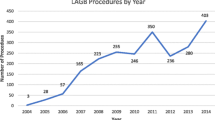Abstract
Background:
Laparoscopic adjustable gastric band (LAGB) has consistently been shown to be a safe and effective treatment for morbid obesity, especially in Europe and Australia. Data from the U.S. regarding the LAGB has been insufficient. This study reveals our experience with 749 primary LAGB over a 3-year period in a U.S. university teaching hospital.
Methods:
All data was prospectively collected and entered into an electronic registry. Characteristics evaluated for this study include preoperative age, BMI, gender, race, conversion rate, operative time, hospital stay, percent excess weight loss (%EWL) and postoperative complications. Annual esophagrams were performed
Results:
From July 2001 through September 2004, 749 patients (531 females, 218 males) underwent LAGB for the treatment of morbid obesity. There were 630 Caucasians, 61 African-Americans, and 49 Latin Americans, with a mean age of 42.3 (range 18, 72 years) and mean BMI of 46.0 ± 7.0 (range 35, 91.5 kg/m2). There was one conversion to open (0.1%). Median operative time and hospital stay were 60 minutes and 23 hours, respectively. The mean %EWL at 1 year, 2 years, and 3 years was 44.4 (±17.8), 51.8 (±20.9), and 52.0 (±19.6), respectively. There were no mortalities. Postoperative complications occurred in 12.8% of patients: 1.5% acute postoperative band obstruction, 0.9% wound infection, 2.9% gastric prolapse (“slip”), 2.0% concentric pouch dilatation (without slip), 0.8% aspiration pneumonia, 2.4% port/tubing problems, 0.3% severe esophageal dilatation/dysmotility (reversible), and 1.5% overall band removal.
Conclusion:
These American results substantiate the data from abroad that LAGB is a safe and effective treatment for morbid obesity.
Similar content being viewed by others
References
Angrisani L, Furbetta F, Doldi S, Basso N, Lucchese M, Giacomelli F, Zaapa M, Di Cosmo L, Veneziani A, Turicchia U, Alkilani M, Forestieri P, Lesti G, Puglisi F, Toppino M, Campanile F, Capizzi F, D’Atri C, Sciptoni L, Giardiello C, Di Lorenzo N, Lacitignola S, Belvederesi N, Marzano B, Bernate P, Iuppa A, Borrelli V, Lorenzo M (2002) Lap Band adjustable gastric banding system: the Italian experience with 1,863 patients operated on 6 years. Surg Endosc 17: 409–412
Belachew M, Belva P, Desaive C (2002) Long-term results of laparoscopic adjustable gastric banding for the treatment of morbid obesity. Obes Surg 12: 567–568
DeMaria E, Sugerman H, Meador J, Doty J, Kellum J, Wolfe L, Szucs R, Turner M (2001) High failure rate after laparoscopic adjustable silicone gastric banding for treatment of morbid obesity. Ann Surg 233: 809–818
Doherty C, Maher J, Heitshusen D (2002) Long-term data indicate a progressive loss in efficacy of adjustable silicone gastric banding for the surgical treatment of morbid obesity. Surgery 132: 724–728
Fielding G, Rhodes M, Nathanson L (1999) Laparoscopic gastric banding for morbid obesity: surgical outcome in 335 cases. Surg Endosc 13: 550–554
O’Brien P, Dixon J (2003) Laparoscopic adjustable gastric banding in the treatment of morbid obesity. Arch Surg 138: 377–382
Ren C, Fielding G (2003) Laparoscopic adjustable gastric banding: surgical technique. J Laparoendosc Adv Surg Tech A 13: 257–263
Rubin M, Spivak H (2003) Prospective study of 250 patients undergoing laparoscopic gastric banding using the two-step technique. Surg Endoc 17: 857–860
Shen R, Dugay G, Rajaram K, Cabrera I, Siegel N, Ren C (2004) Impact of patient follow-up on weight loss after bariatric surgery. Obes Surg 14: 514–519
Shen R, Ren C (2004) Removal of perigastric fat prevents acute obstruction after Lap-Band surgery. Obes Surg 14: 224–229
Zinzindohoue F, Chevallier J, Douard R, Elian N, Ferraz J, Blanche J, Berta J, Altman J, Safran D, Cugnenc P (2002) Laparoscopic gastric banding: a minimally invasive surgical treatment for morbid obesity: a prospective study of 500 consecutive patients. Ann Surg 237: 1–9
Acknowledgments:
The authors acknowledge Heekoung Young RN, MA and Michelle Secic, MS.
Author information
Authors and Affiliations
Rights and permissions
About this article
Cite this article
Parikh, M.S., Fielding, G.A. & Ren, C.J. U.S. experience with 749 laparoscopic adjustable gastric bands: intermediate outcomes. Surg Endosc 19, 1631–1635 (2005). https://doi.org/10.1007/s00464-005-0302-7
Received:
Accepted:
Published:
Issue Date:
DOI: https://doi.org/10.1007/s00464-005-0302-7




